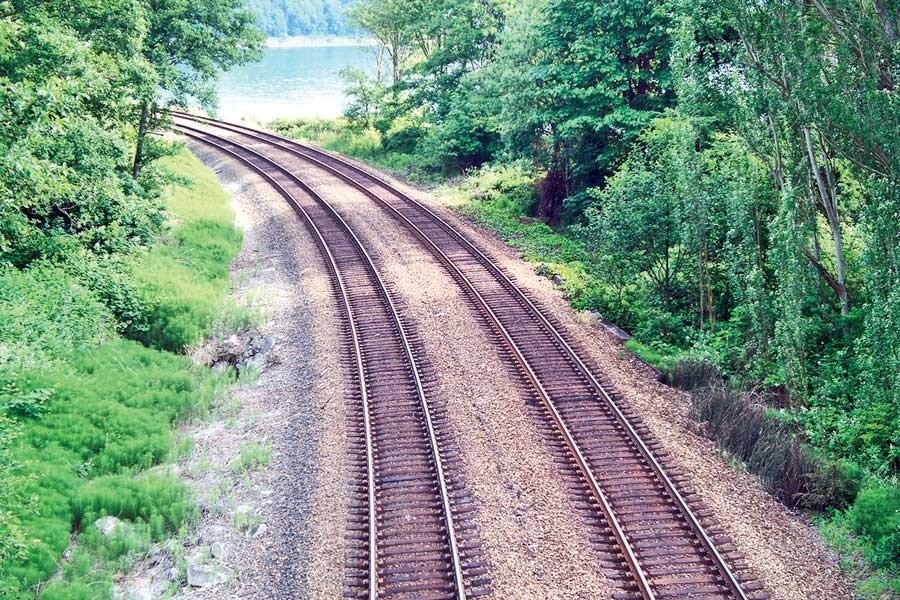Tuesday's train accident -- worst of its kind in a decade in this country -- at Mandobag in Kasba under Brahmanbaria has raised more questions about the railway service than can be answered. The popularly held belief that train journeys are safer compared with road travel in the land will be seriously dented by this latest railway disaster. When a train rams into another from the sideway, the impact can be anyone's guess. It was no different in the case of the accident involving two intercity trains - Turna Nishita and Udayan Express.
Accusing fingers have been pointed at the train driver of Turna Nishita, who is suspected to have violated the signal. A report carried in a Bangla contemporary claims the driver was drowsy at the time of crashing his engine into the other train. If this is so, how can the man survive, let alone flee. The fact is both the driver and his assistant have managed to flee the scene. They fled but the three carriages that directly received the impact of the collision were smashed into pieces with mangled bodies of passengers, including children, strewn or pressed under the debris. Sixteen people were reported dead and more than a hundred injured.
On June this year, in another train accident at Boromchal, in Kulaura Upazila, five people were killed and about 150 injured. In that accident, three carriages also derailed on a bridge and one of those fell into a canal and the other two on the canal's bank. In July nine oil carriages got derailed at Charghat, forcing suspension of train services to and from Rajshahi for 72 hours. In another incident, a train left without the locomotive master who made a habit of getting on board the train midway after his assistant has operated up to a certain point in his absence.
Clearly the malaise the Bangladesh railway suffers from is deep-rooted and the increasing frequency of disasters is likely to prove the comparative safer rail journey a fiction soon. True, railway is receiving more investment than before but the mindset of those involved with improvement of this mode of transport has not changed much. The nine oil carriages derailed at Charghat on account of criminal neglect of the men who were repairing the old slippers. Pins (dog spikes) that hold slippers to railway tracks were removed at the time of repair but not reattached before covering those with stone chips. So the rail tracks gave in and the accident happened. Then there were reports that engineers approved of bamboo strips to hold railway tracks tight at some point. This is ludicrous.
All this is nothing more than the symptom, the real disease lies far deeper. Some quarters are averse to modernising the Bangladesh Railway to a point where it assumes the premier role of transportation in the country. Systematic neglect earlier rendered the rail service a much maligned mode. Continued loss, theft of fans, articles of furniture and diesel from trains and engine brought the BR to disrepute. Fortunately, it has come a long way off from that deplorable state. But still the BR has miles to go if it really means business.
The import of diesel electric multiple unit (DEMU) may be cited as an example of injudicious procurement of coaches and engines with scant regard for the railway tracks, weather and platforms. Passengers complain of suffocation inside the carriage because of inadequate ventilation and the height of the door-steps does not match with the platforms here.
That the policymakers have directed their focus on railway is understood but it has not been complemented at the implementing stage. True, there is need for massive investment in the country's railway but one has to be sure that whatever expenditure is made on the sector is done fairly and pragmatically. The rickety railway tracks with loose slippers and sparse stone chips present a miserable look. One who has travelled by the Moitree train can appreciate this well. On the Indian side, the train runs smoothly and fast but on the Bangladesh side, the train swerves rather dangerously on segments of tracks. All because the tracks are weak and ill maintained.
Now that the prime minister has expressed her intention of introducing electric trains within years, it would be incumbent on the railway authority to pay attention to the railway tracks on a priority basis. The old tracks have to be replaced and if need be laid anew in order to strengthen their load capacity. Electric trains run fast and many of their functions are digitised. That may be of great help at times to avoid accidents like the one at Mandobag, Brahmanbaria.
Indeed technology has advanced to an incredible extent. A few years back, it was reported that an Indian engineer has developed a device which can automatically detect a train coming from the opposite direction on the same track. If both trains have the device fitted to them, the trains would automatically stop with 200 yards separating the two. This is worth going into. Modernising and minding the safety issue are interlinked. Only there is a need for a clear intention of executing things in order to put in place the desired improvement.


